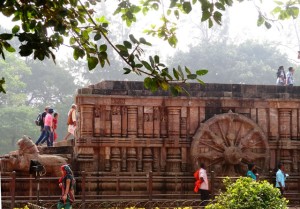 The Konark Sun Temple was built in the 13th century, near the mouth of the Chandrabhaga River, during the reign of Narasimhadeva I. The river has receded significantly since then, leaving the temple surrounded by an open field of dry land. The temple is built in a shape of a gigantic chariot, with 24 large wheels and 7 horses pulling the chariot. The temple served as an important land mark for passing by sailors and was referred to it as the “Black Pagoda”. It is featured as one of the seven wonders of India. UNESCO declared it a World Heritage Site in 1984.
The Konark Sun Temple was built in the 13th century, near the mouth of the Chandrabhaga River, during the reign of Narasimhadeva I. The river has receded significantly since then, leaving the temple surrounded by an open field of dry land. The temple is built in a shape of a gigantic chariot, with 24 large wheels and 7 horses pulling the chariot. The temple served as an important land mark for passing by sailors and was referred to it as the “Black Pagoda”. It is featured as one of the seven wonders of India. UNESCO declared it a World Heritage Site in 1984.
Konark Sun Temple Architecture and Symbolism
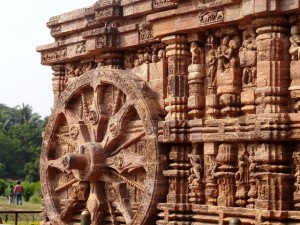 The Konark Sun Temple is an excellent example of the Kalinga architecture. Loyal to Kalinga style, all the structural components including walls, pillars and wheels are highly ornamented with wide range of statues and carvings. In this architectural style, history, folklore, iconography and mythology are traditional themes. The revealing erotic carvings depicting maithunas ( sacred sexual union) are quite obvious and draw prime attention of the tourists.
The Konark Sun Temple is an excellent example of the Kalinga architecture. Loyal to Kalinga style, all the structural components including walls, pillars and wheels are highly ornamented with wide range of statues and carvings. In this architectural style, history, folklore, iconography and mythology are traditional themes. The revealing erotic carvings depicting maithunas ( sacred sexual union) are quite obvious and draw prime attention of the tourists.
 This colossal temple complex consists of a sanctum sanctorum, which used to be 229 ft tall, audience hall, dancing hall and dining hall. This magnificent temple was erected in honor of Surya, the Sun God. It is in a shape of a chariot pulled by 7 horses, oriented towards the East, to ensure that the main entrance receives the first rays from the sun each day.
This colossal temple complex consists of a sanctum sanctorum, which used to be 229 ft tall, audience hall, dancing hall and dining hall. This magnificent temple was erected in honor of Surya, the Sun God. It is in a shape of a chariot pulled by 7 horses, oriented towards the East, to ensure that the main entrance receives the first rays from the sun each day.
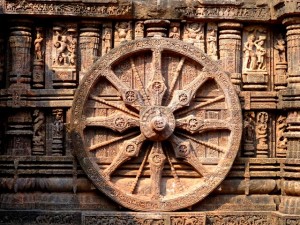 The striking element of The Konark Sun Temple is 24 wheels, each of which is 10 feet in diameter, featuring elaborate carvings. These wheels create a Sun Dial, and can be used to calculate the hour of the day down to the minute accurately. This functionality is possible thanks to the shadow patterns in the spokes and other elaborate carving on the wheels.
The striking element of The Konark Sun Temple is 24 wheels, each of which is 10 feet in diameter, featuring elaborate carvings. These wheels create a Sun Dial, and can be used to calculate the hour of the day down to the minute accurately. This functionality is possible thanks to the shadow patterns in the spokes and other elaborate carving on the wheels.
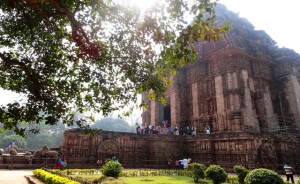 The Konark Sun Temple was built with Khondalite rock, with iron beams between every two-stone blocks. These bars are believed to reinforce the overall robustness of the monument. The use of metal reinforcements is unheard of in the 13th century, making it quite an unusual structure of that time. Local legends claim that the original main tower (the sanctum sanctorum) had a 52 ton magnet arrangement at the top which caused the “idol” to float in air.
The Konark Sun Temple was built with Khondalite rock, with iron beams between every two-stone blocks. These bars are believed to reinforce the overall robustness of the monument. The use of metal reinforcements is unheard of in the 13th century, making it quite an unusual structure of that time. Local legends claim that the original main tower (the sanctum sanctorum) had a 52 ton magnet arrangement at the top which caused the “idol” to float in air.
Nearby Attractions around Konark
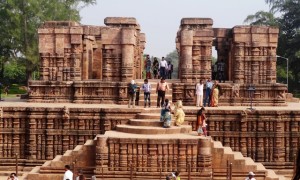 Close to this iconic monument, visitors can find two other smaller temples. The Mayadevi Temple, as the name suggests, is believed to have been dedicated to Mayadevi – a wife of the Surya in Hindu mythology. The ruins of the temple date from the 11th century. Southwest of this are the ruins of another mysterious temple dedicated to Vaishnava Devi. Beautiful sculptures of Trivikrama, Balarama and Varaha can be found nearby. The main structures of these temples are missing, but both are believed to have been symbolically related to the main Sun Temple.
Close to this iconic monument, visitors can find two other smaller temples. The Mayadevi Temple, as the name suggests, is believed to have been dedicated to Mayadevi – a wife of the Surya in Hindu mythology. The ruins of the temple date from the 11th century. Southwest of this are the ruins of another mysterious temple dedicated to Vaishnava Devi. Beautiful sculptures of Trivikrama, Balarama and Varaha can be found nearby. The main structures of these temples are missing, but both are believed to have been symbolically related to the main Sun Temple.
Around Puri and Bhuvaneshwar:
- Both these towns have abundant ancient monuments including Hindu temples dating back to 7th century. The most remarkable of them is the “64 Yogini Temple”, located 50 kms outside Bhuvaneshwar, Dating back to 9t century, this temple depicts sacred feminine force in 64 forms!
- Another interesting place nearby is the Heritage village of Raghurajpur. This heritage crafts village is home various traditional artisans who use ancient craft techniques dating back to 5th century BC.
How to reach Konark Sun Temple:
Popularly known as Puri Temple, the Konark Sun Temple is located 35 kms from Puri and 65 kms from Bhuvaneshwar. It is easily accessible by road which connects Puri to Bhuvaneshwar.

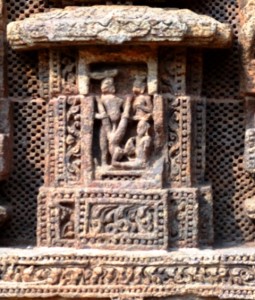
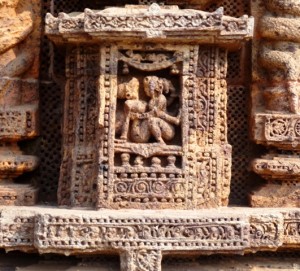

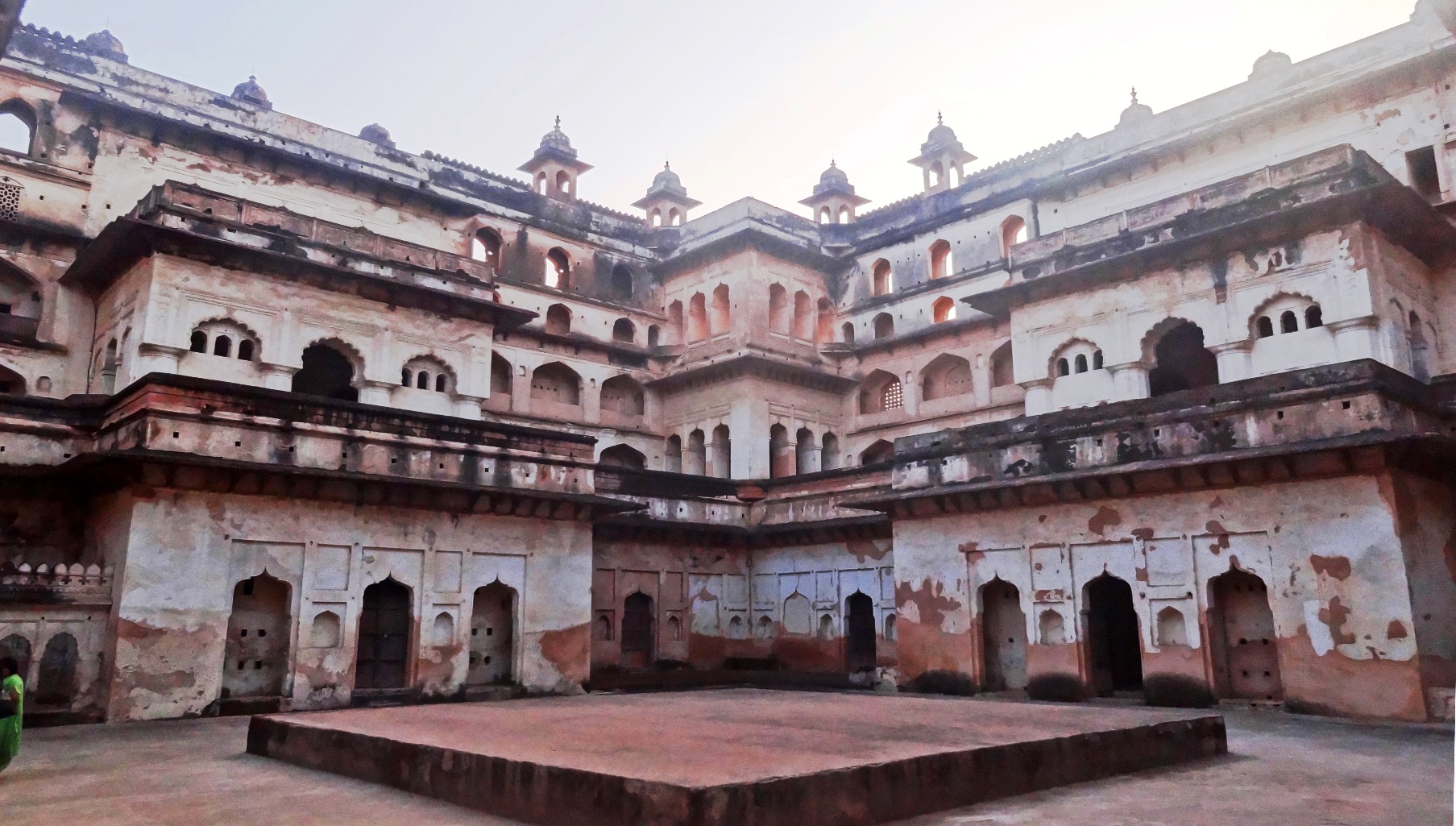
Pingback: Raghurajpur: Heritage Village by Orissa Tourism